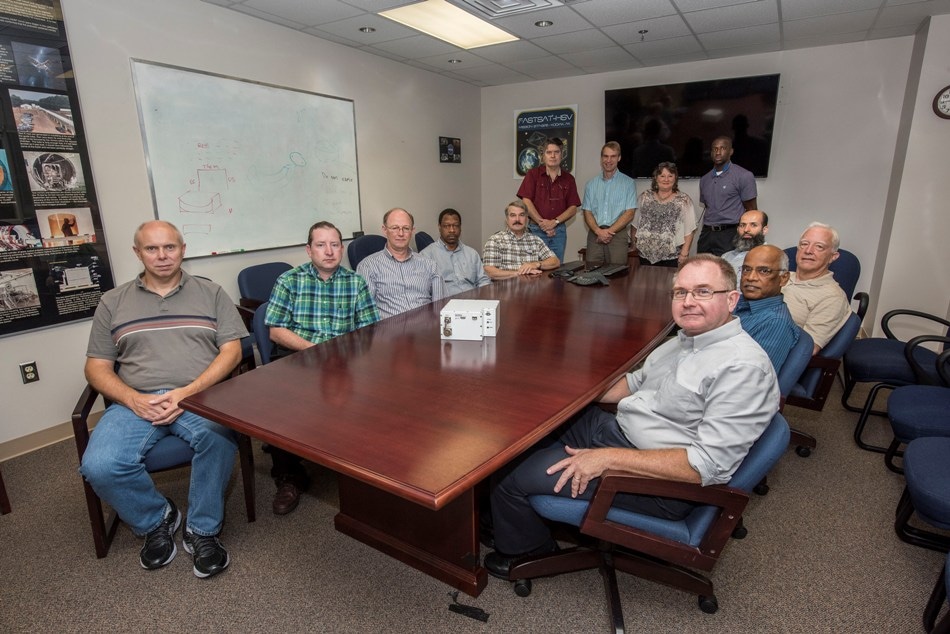Apr 6 2017
Long-term exposure to high levels of cosmic radiation is a major health concern of living and working in space. To resolve this problem, NASA scientists have come up with an innovative device to track radiation exposure to neutrons. The device is being tested on the International Space Station.
 The team of scientists and engineers that designed and built the Fast Neutron Spectrometer at NASA�s Marshall Space Flight Center in Huntsville, Alabama, gather around their device before it is shipped to the processing facility in Houston for launch. (Credits: NASA/Fred Deaton)
The team of scientists and engineers that designed and built the Fast Neutron Spectrometer at NASA�s Marshall Space Flight Center in Huntsville, Alabama, gather around their device before it is shipped to the processing facility in Houston for launch. (Credits: NASA/Fred Deaton)
The Fast Neutron Spectrometer, launched on the fifth Orbital ATK resupply mission to the International Space Station, can detect and quantify the energy of neutrons, which are particularly harmful to human beings. Therefore, a better understanding of neutron radiation will ensure the crews’ safety when NASA deploys humans to Mars.
There are multiple types of radiation in space. While there are already advanced instruments to detect gamma rays produced by supernovas or black holes, X-rays and other charged particles, we needed a way to detect and measure neutron radiation to quantify the impact on human biology. Neutron detection techniques have not seen the same leap in technology advancement.
Mark Christl, team lead for the study at NASA’s Marshall Space Flight Center in Huntsville, Alabama.
Neutron radiation is generally produced when high-energy particles from the sun and beyond the solar system interact with other matter or particles, for instance a spacecraft or a planetary surface. However, these neutrons decay into charged particles and are only feasible for about 13 minutes.
If they’re more than 13 minutes away from you, it’s not really a problem. If you’re in a capsule or on a planet’s surface with little or no magnetic field or atmosphere, you can potentially be covered in a neutron field.
Christl
The Fast Neutron Spectrometer developed by NASA primarily serves as a passive tool, waiting for neutrons to hit it. It includes an aluminum housing with a plastic scintillator, which slows down the neutrons when they strike the device. It also includes glass scintillator fibers that are capable of absorbing the neutrons and re-emitting the energy in the form of light. This is a sophisticated version that offers two separate signals for measurement – the first signal to measure its energy and the second one to verify that a neutron was indeed detected instead of another kind of particle or matter. However, the typical, all-plastic devices are not able to fully determine the variations between these two signals.
Detectors for other radiation types are already used in many industries. They’re used in particle accelerators for scientific research, the oil industry or medical field to measure radiation exposure. Scientists have been working on remarkable advancements in these detectors, but neutron radiation detectors have not received that kind of attention. At NASA, we saw this as an opportunity to address a problem our astronauts will have as they go on longer journeys in our solar system.
Christl
The Fast Neutron Spectrometer was installed on the International Space Station on December 2, 2016 by NASA astronaut, Shane Kimbrough. Since that time, the device has been shifted to a variety of locations around the station’s interior and it is presently located in the Node 1 module. The spectrometer will track neutrons for a period of six months and send data whenever a neutron strikes at a laptop PC on the station. The data obtained will be downloaded every day and will be processed and analyzed by the crew at Marshall.
The device underwent testing and calibration at particle accelerators and was also tested with other radioactive sources on Earth. If this method is confirmed, Christl hopes that the device can be employed in future missions to establish when and how much the neutrons contribute to the radiation absorbed by space travelers. Although the radiation environment in the International Space Station is not believed to be “deep space,” the Fast Neutron Spectrometer presents a new capability ready for validation in a space surrounding.
The study is a joint effort within the agency. A research group at NASA’s Langley Research Center in Hampton, Virginia, is exploring the actions the crew may take if they receive warning of an oncoming radiation wave from a solar explosion, performing simulations and developing new ways to reorganize the spacecraft‘s contents to improve the shielding. At NASA’s Johnson Space Center in Houston, another group is developing the detection of charged particles.
There is a serious need to monitor the radiation dose the crew receives. We use different techniques for charged particles and neutrons and we’ll need to know the dose from both to know how much radiation the astronauts are receiving. These radiation detectors may force missions to change in mid-stream, but it will help keep our astronauts safe.
Christl